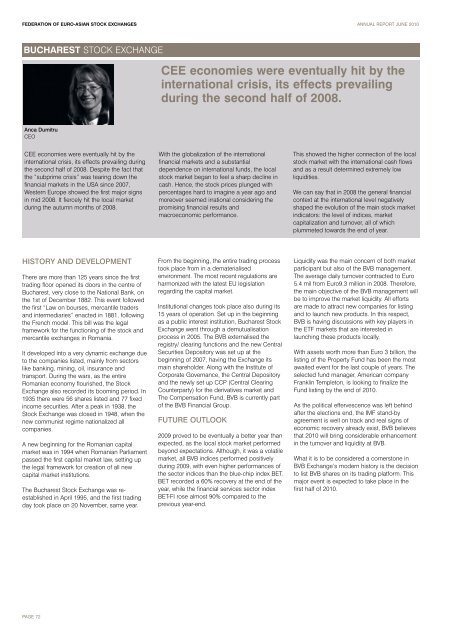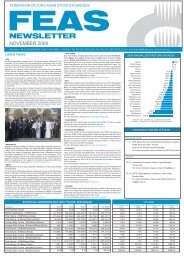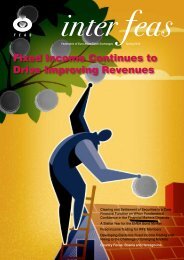Download - FEAS
Download - FEAS
Download - FEAS
- No tags were found...
Create successful ePaper yourself
Turn your PDF publications into a flip-book with our unique Google optimized e-Paper software.
FEDERATION OF EURO-ASIAN STOCK EXCHANGES ANNUAL REPORT JUNE 2010BUCHAREST STOCK EXCHANGECEE economies were eventually hit by theinternational crisis, its effects prevailingduring the second half of 2008.Anca DumitruCEOCEE economies were eventually hit by theinternational crisis, its effects prevailing duringthe second half of 2008. Despite the fact thatthe “subprime crisis” was tearing down thefinancial markets in the USA since 2007,Western Europe showed the first major signsin mid 2008. It fiercely hit the local marketduring the autumn months of 2008.With the globalization of the internationalfinancial markets and a substantialdependence on international funds, the localstock market began to feel a sharp decline incash. Hence, the stock prices plunged withpercentages hard to imagine a year ago andmoreover seemed irrational considering thepromising financial results andmacroeconomic performance.This showed the higher connection of the localstock market with the international cash flowsand as a result determined extremely lowliquidities.We can say that in 2008 the general financialcontext at the international level negativelyshaped the evolution of the main stock marketindicators: the level of indices, marketcapitalization and turnover, all of whichplummeted towards the end of year.HISTORY AND DEVELOPMENTThere are more than 125 years since the firsttrading floor opened its doors in the centre ofBucharest, very close to the National Bank, onthe 1st of December 1882. This event followedthe first “Law on bourses, mercantile tradersand intermediaries” enacted in 1881, followingthe French model. This bill was the legalframework for the functioning of the stock andmercantile exchanges in Romania.It developed into a very dynamic exchange dueto the companies listed, mainly from sectorslike banking, mining, oil, insurance andtransport. During the wars, as the entireRomanian economy flourished, the StockExchange also recorded its booming period. In1935 there were 56 shares listed and 77 fixedincome securities. After a peak in 1938, theStock Exchange was closed in 1948, when thenew communist regime nationalized allcompanies.A new beginning for the Romanian capitalmarket was in 1994 when Romanian Parliamentpassed the first capital market law, setting upthe legal framework for creation of all newcapital market institutions.The Bucharest Stock Exchange was reestablishedin April 1995, and the first tradingday took place on 20 November, same year.From the beginning, the entire trading processtook place from in a dematerialisedenvironment. The most recent regulations areharmonized with the latest EU legislationregarding the capital market.Institutional changes took place also during its15 years of operation. Set up in the beginningas a public interest institution, Bucharest StockExchange went through a demutualisationprocess in 2005. The BVB externalised theregistry/ clearing functions and the new CentralSecurities Depository was set up at thebeginning of 2007, having the Exchange itsmain shareholder. Along with the Institute ofCorporate Governance, the Central Depositoryand the newly set up CCP (Central ClearingCounterparty) for the derivatives market andThe Compensation Fund, BVB is currently partof the BVB Financial Group.FUTURE OUTLOOK2009 proved to be eventually a better year thanexpected, as the local stock market performedbeyond expectations. Although, it was a volatilemarket, all BVB indices performed positivelyduring 2009, with even higher performances ofthe sector indices than the blue-chip index BET.BET recorded a 60% recovery at the end of theyear, while the financial services sector indexBET-FI rose almost 90% compared to theprevious year-end.Liquidity was the main concern of both marketparticipant but also of the BVB management.The average daily turnover contracted to Euro5.4 mil from Euro9.3 million in 2008. Therefore,the main objective of the BVB management willbe to improve the market liquidity. All effortsare made to attract new companies for listingand to launch new products. In this respect,BVB is having discussions with key players inthe ETF markets that are interested inlaunching these products locally.With assets worth more than Euro 3 billion, thelisting of the Property Fund has been the mostawaited event for the last couple of years. Theselected fund manager, American companyFranklin Templeton, is looking to finalize theFund listing by the end of 2010.As the political effervescence was left behindafter the elections end, the IMF stand-byagreement is well on track and real signs ofeconomic recovery already exist, BVB believesthat 2010 will bring considerable enhancementin the turnover and liquidity at BVB.What it is to be considered a cornerstone inBVB Exchange’s modern history is the decisionto list BVB shares on its trading platform. Thismajor event is expected to take place in thefirst half of 2010.PAGE 72
















